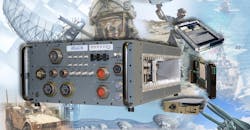Open System Serves Sensor-Based Applications
The sensor open systems architecture (SOSA) is showing the flexibility and versatility to adapt electronic function modules, such as single board computers (SBCs), from different suppliers within flight-qualified electronic-warfare (EW), and a radar system chassis. The SOSA technical standard was just used in a 3U VPX C4ISR demonstrator system for the U.S. Army using a combination of modules from Pentek, Herrick Technology Laboratories, and Kontron and taking advantage of the module interoperability of the SOSA standard.
“Herrick Technology Laboratories, Inc. of Germantown, Md., and another major U.S. system integrator have received shipments of the Kontron VX305C-40G SOSA aligned SBC for U.S. defense community applications,” said Mark Littlefield, Kontron’s vertical product manager for defense and SOSA standard contributor. “Herrick has integrated this SBC with a Model 71813 XMC board from Pentek which provides customizable I/O signal status and control for their new SOSA command, control, communications, computers, intelligence, surveillance, and reconnaissance (C4ISR) demonstrator system for the U.S. Army.”
A goal of the SOSA Consortium is to create a common framework for transitioning sensor systems to an open systems architecture based on standards established by industry-government agreement. The SOSA standard establishes guidelines for C4ISR systems and promises many benefits, including improved interoperability of function modules, reduced systems development times, and reduced development costs.
The C4ISR demonstrator system was enclosed in an HTL.v-C-19 chassis with 16 payload slots and three power supply slots. Two slots were occupied by Kontron model VX305C-40G SBC and Pentek model 71813 digital input/output (I/O) XMC modules along with eight payload slots with multiple HTLv-1 and HTLv-2 dual- and quad-channel HF/VHF/UHF transceiver modules. In addition, several slots housed Gigabit Ethernet switches and one slot held a precision navigation and timing reference module. The interoperability of the modules from different vendors shows that system-level designs can be constructed with the open architecture approach by plugging in function modules as needed.
About the Author
Jack Browne
Technical Contributor
Jack Browne, Technical Contributor, has worked in technical publishing for over 30 years. He managed the content and production of three technical journals while at the American Institute of Physics, including Medical Physics and the Journal of Vacuum Science & Technology. He has been a Publisher and Editor for Penton Media, started the firm’s Wireless Symposium & Exhibition trade show in 1993, and currently serves as Technical Contributor for that company's Microwaves & RF magazine. Browne, who holds a BS in Mathematics from City College of New York and BA degrees in English and Philosophy from Fordham University, is a member of the IEEE.

